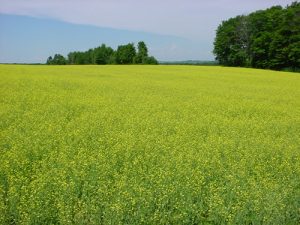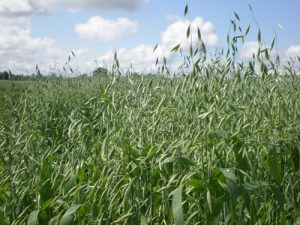Maine Grain and Oilseed Newsletter, Vol. 1, No. 1 – April 2013
In this issue:
Dear Grower,
This is the first issue of the Maine Grain and Oilseed Newsletter. In response to the growing number of questions from farmers regarding the production of grains and oilseeds, we decided that it was best to start a newsletter that will, hopefully, provide timely, research-based knowledge to Maine’s producers. This newsletter will be distributed on a monthly or “as-needed” basis throughout the year. The newsletter will be available through e-mail, and will be posted online to make reading on certain electronic devices easier. If you do not want to receive the newsletter, or know of someone who would like to receive the newsletter, please contact me at aplant@maine.edu to be removed from or added to the e-mail list.
This first newsletter contains information on seed selection, market standards, and assessing the viability of fall-sown winter grains. We hope you will find this information useful to your production needs.
Sincerely,
Andrew Plant, Extension Agriculture Educator
57 Houlton Road, Presque Isle, ME 04769
207.764.3361 or 1.800.287.1462
extension.umaine.edu/aroostook
Know Your Grain, Know Your Market
Andrew Plant, Extension Agriculture Educator, UMaine Extension
 One of the important aspects for successful crop production for growers to consider before they venture into the fields to plant their grain and oilseed crops has more to do with where and what happens to one’s crop after harvest. Knowing your market (or potential market) prior to planting time will help guide growers to make specific decisions throughout the growing season. For any one crop, dependent upon the end-use market, growers may consider varying fertility, seeding rates, row spacing, disease management, insect management, harvest time, drying capability, and storage capacity.
One of the important aspects for successful crop production for growers to consider before they venture into the fields to plant their grain and oilseed crops has more to do with where and what happens to one’s crop after harvest. Knowing your market (or potential market) prior to planting time will help guide growers to make specific decisions throughout the growing season. For any one crop, dependent upon the end-use market, growers may consider varying fertility, seeding rates, row spacing, disease management, insect management, harvest time, drying capability, and storage capacity.
Most every crop grown in our rotations has a specific set of grading standards to aid in determining its quality and resulting best fit into the marketplace. Included below are websites that provide information pertaining to grading standards for the US and Canada, for most of these crops. Also listed below are some general crop variables that are measured in these standards. It’s useful to look through these crop standards to determine what your crop may need in order to achieve the grade that you want.
Grain and Oilseeds Standards Websites
- United States: Official U.S. Standards
- Canada: Official Grain Grading Guide
Typical Quality Parameters for Grains and Oilseeds
- Test Weight
- % Soundness (whole kernels/seeds)
- % Damaged Kernels/Seeds
- % Foreign Material
- % Broken Kernels/Seeds
- Presence of odors or mold
- Color
Beyond these general grading standards, specific markets may impose further standards of quality. In grains, protein levels are typically important for some markets; in oilseeds, oil content maybe of importance. As an example, the bread wheat flour market is one of the more lucrative markets to sell into, but is also one of the more restrictive in regards to standards. Beyond what’s listed above, minimum protein level, falling number score (measuring amylase activity), DON level (mycotoxin), and known varietal baking performance, are usually taken into account.
Probably the single-most important determinant of successful, marketable, crop production is going to be variety selection. It is important to research and talk to your market outlets to figure out which varieties suit their needs and of those varieties, which have been successfully grown locally.
Assessing Winter Grain Stands
Ellen Mallory, Sustainable Agriculture Specialist, UMaine Extension
Once the snow melts and temperatures rise, it’s time to look at how well our fall-seeded grains, like winter wheat, triticale and spelt, survived the winter. Winter grains have many advantages over their spring counterparts (less weed pressure, higher yield potential, lessened spring workload), but over-wintering is not always assured. Late fall planting, poorly adapted varieties, and adverse weather conditions can all contribute to poor stands in the spring. This winter’s weather conditions were particularly challenging for winter grains with intermittent snow cover and periods of surface melting followed by icing. Low lying areas of fields are likely to be most affected.
When assessing winter survival, first get a sense of how patchy the field looks, and then focus initially on the worst-looking areas. If those areas turn out to be OK, the rest of your field should also be fine. As you scout, be aware that dried, brown leaves do not necessarily indicate that the plants are dead. Likewise, green leaves do not necessarily indicate the plants have survived. The only way to know the status of individual plants is to peel back any dead, outer leaves and examine the crown. A healthy plant should have a bright, white crown with new white roots developing once temperatures have been warm enough for new growth.
Is the stand worth keeping?
First, count the number of plants per square foot to determine if the stand is worth keeping. To do this, take a yardstick, count the number of healthy plants in the three-foot length, and write it down. Be sure to count individual plants, not tillers. Do this in several areas that are representative of the field or the patches you are examining. Calculate the average of these numbers, then multiple that number by 4 and divide by your row width. This will give you the average number of plants per foot. For example, 35 (plants per 3 foot length) x 4 ÷ 7 (inch rows) = 20 plants per square foot. Plant stands with 20-30 plants per square foot are considered optimum. Stands with 12-15 should be adequate, especially if nitrogen can be applied to stimulate tillering (see below). If the number of plants per square foot is less than 8-12, consider replanting the field to another crop.
If you determine the crop is worth keeping, but are concerned about bare patches, consider underseeding clover to compete with weeds. Do not inter-seed spring wheat into winter wheat as they will ripen at two different times.
Is additional nitrogen needed, and when?
For winter grains, it is recommended to delay the application of a portion of nitrogen until spring to avoid over winter loss. When in the spring you make this topdress nitrogen application will depend on your plant stand. An early application in the spring will stimulate tillering, thereby increasing the number of heads per square foot but could be subject to leaching losses if spring rainfall is heavy, whereas a later spring application may be used more efficiently by the crop. To decide if early nitrogen topdressing is necessary, count the number of tillers per square foot. Use the same counting method as above, but count all mainstems and tillers with three or more leaves in the three-foot length of row. Calculate tillers per square foot also as above. If tiller numbers are less than 70 tillers per square foot, consider topdressing additional nitrogen while the crop is in the early tillering stage. If tiller counts are above 70 tillers per square foot, delay your spring topdressing until just before the plants start to joint (i.e. stems elongate), which is when the plants enter their most rapid stage of growth.
For more information on spring stand assessment and spring topdressing, see NDSU Small Grains News.
Sourcing Quality Seed
Tom Molloy, Research Associate, UMaine Plant, Soil, & Environmental Sciences
 Sourcing high quality seed is the first step in achieving maximum yields from your crop. Although saving and using seed from a previous crop is fairly common, buying in new high quality seed from a reputable dealer is the best way to assure you start the season on the right foot. When sourcing seed you need to make sure it has varietal purity, good germination and is free of weeds and other materials. Another quality consideration is seed size. Research has shown that seed lots with larger grain kernels are more vigorous, more competitive with weeds, and have higher yields.
Sourcing high quality seed is the first step in achieving maximum yields from your crop. Although saving and using seed from a previous crop is fairly common, buying in new high quality seed from a reputable dealer is the best way to assure you start the season on the right foot. When sourcing seed you need to make sure it has varietal purity, good germination and is free of weeds and other materials. Another quality consideration is seed size. Research has shown that seed lots with larger grain kernels are more vigorous, more competitive with weeds, and have higher yields.
The easiest way to assure this is to buy certified seed. Most states and Canada have seed certification programs that use a combination of field inspections and seed testing to certify seed. Certified seed will have a blue tag on it that states the variety (meaning the variety stated on the tag is the same as what is in the bag), seed lot number, percent of pure seed, percent of other crop seed, inert matter, weed seeds, and the germination rate. Becoming more commonplace is a statement of seeds per pound, which is useful to have when determining seeding rates. Often times, even though it may not be stated on the tag, the seed dealer may have the seeds per pound information should you call and ask for it.
If you do plan on saving and using your own seed you should make sure it is cleaned to remove small or cracked kernels, weed seeds and other debris. It is also recommended that you conduct a germination test. If germination numbers are low (<80% for cereals) and the seed is slow to germinate then you should avoid planting that seed lot. It is best to run the germination test in the spring to take into account any storage issues that might have affected the germination. It is also important to get a representative sample, which can be challenging depending on the type of storage. For more in-depth information on conducting your own germination tests, see Bulletin #1013, Testing Small-Grain Germination. Lastly, treating the seed with appropriate seed treatments is also a good idea to reduce the potential of seed-born diseases, some head diseases, and in some cases insects, depending on your individual situation.
Information on this website is provided purely for educational purposes. No responsibility is assumed for any problems associated with the use of products or services mentioned. No endorsement of products or companies is intended, nor is criticism of unnamed products or companies implied.
© 2013
Call 800.287.0274 or TDD 800.287.8957 (in Maine), or 207.581.3188, for information on publications and program offerings from University of Maine Cooperative Extension, or visit extension.umaine.edu.
